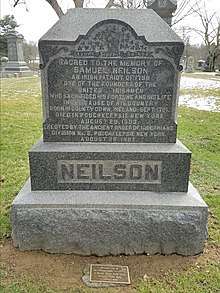Samuel Neilson
Samuel Neilson (17 September 1761 – 29 August 1803) was a founding member of the Society of United Irishmen and the founder of its newspaper, the Northern Star.
Samuel Neilson | |
|---|---|
_(after_Charles_Byrne).jpg) | |
| Born | September 17, 1761 Ballyroney, County Down, Ireland |
| Died | August 29, 1803 (aged 41) |
| Resting place | Poughkeepsie Rural Cemetery |
| Occupation | Newspaperman |
| Organization | United Irishmen |
Notable work | Northern Star |
| Home town | Belfast, Ireland |
| Movement | Irish Rebellion of 1798 |
| Criminal charge(s) | High treason |
| Criminal penalty | Exile |
Background
Neilson was born in Ballyroney, County Down, Ireland, the son of Presbyterian minister Alexander, and Agnes Neilson. He was educated locally. Neilson was the second son in a family of eight sons and five daughters. At 16 years of age, Neilson was apprenticed to his elder brother, John, in the business of woollen drapery in Belfast. At the age of 24 he established his own business.[1]
United Irishman
Despite his commercial success, Neilson was drawn to politics and had early on been a member of the reformist Volunteer movement.[2] In 1791, inspired by the French Revolution, he suggested to Henry Joy McCracken the idea of a political society of Irishmen of every religious persuasion. He helped establish the United Irishmen in Belfast. In 1792 he launched the newspaper of the United Irishmen, the Northern Star,[1] which effectively bankrupted him. As its editor he was a high-profile target for the authorities and was prosecuted for libel several times, being twice imprisoned between 1796-98. When war broke out between Britain and France in 1793 the United Irishmen became involved in military efforts to help liberate Ireland from the control of Britain while Britain was distracted due to the war with France. With the assistance of France the United Irishmen began to wage a war against Britain to release Ireland from the control of Britain. Samuel Neilson was a driving force on the ground in Ireland, helping organise groups of Irishmen as soldiers in the battle of gaining independence from Britain.
Plans for rebellion
Along with several other "state prisoners" (persons imprisoned indefinitely without charge) Neilson was released in February 1798 following several petitions by influential friends, on grounds of bad health. Upon release he immediately involved himself in the United Irishmen, aligning with the radicals among the leadership who were pressing for immediate rebellion and opposed to the moderates who wished to wait for French assistance before acting.
The United Irishmen were, however, severely infiltrated by informers, among them Thomas Reynolds,[2] who kept Dublin Castle abreast of their plans and discussions. In March 1798, information of a meeting of the United Irish executive at the house of Oliver Bond led to the arrest of most of the leadership, leaving Neilson and Lord Edward Fitzgerald the only figures of national importance still at liberty. They decided to press ahead as soon as possible and settled on 23 May as the date for the rebellion to begin.
Arrests
As the date loomed closer, the authorities went into overdrive to sweep up the rump leadership, and on 18 May Lord Edward was betrayed in his hiding place and critically wounded while resisting capture. Neilson, now with responsibility for finalising plans for the looming rebellion, decided that Fitzgerald was too valuable to do without and decided to try and rescue him from Newgate Prison in Dublin. Wary of confiding his plans too early for fear of betrayal, Neilson went on a reconnaissance of the prison but was spotted by one of his former jailers, and after a fierce struggle, he was overpowered and dragged into the prison.
Imprisonment and exile

Neilson was indicted for high treason and held in Kilmainham Jail with other "state prisoners" for the duration of the doomed rebellion outside.[2] After the execution of Oliver Bond and the brothers John and Henry Sheares, Neilson and the remaining prisoners agreed to provide the authorities with details of the organisation of the United Irishmen and plans for the rebellion in exchange for a sentence of exile. Following the suppression of the rebellion, he was transferred to Fort George in Inverness-shire, Scotland, and in 1802 he was deported to the Netherlands. From there he made his way to America, arriving in December 1802. Neilson was preparing to revive the Northern Star and bring his family over from Ireland when an outbreak of yellow fever struck the city in August 1803. He took ill while traveling up the Hudson River and landed at Poughkeepsie on Sunday, August 28. He died the next morning.[2]
References
- "Samuel Neilson". Dictionary of Ulster Biography. Retrieved 2008-07-09.
- Mark, Joshua J., "‘A planet of light and heat’: Samuel Neilson and the Northern Star", History Ireland, Issue 6 (November/December 2015), Vol. 23